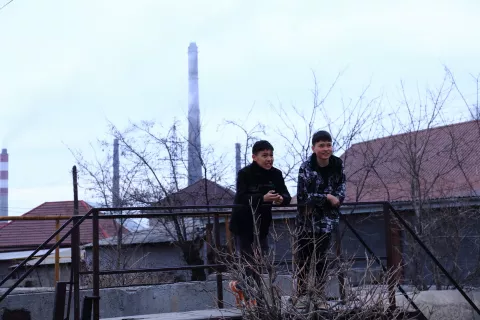Children with pneumonia, COVID-19 Red Zone and medicines
Essential medicines, worth $100,000, funded by the European Union and supported by UNICEF, have been distributed to the Ministry of Health and Social Development

Issyk-Kul, 09 April 2021 - This is the "Red Zone", set up to respond to the COVID-19 pandemic in the infectious ward at the Regional Hospital in Cholpon-Ata, in the Issyk-Kul province. From the beginning of 2020 until the end of March 2021, 725 children with different health conditions under 14 year old have been treated in the hospital.
A woman is walking up and down the ward's corridor, spending days and nights at the hospital. She is a mother, and her five-year-old, Izati, is suffering from pneumonia.
Recently, Izati's condition got better. Nurgul, the mother, states with relief: "Thanks to a competent approach to care, treatment and medication, her condition has improved".
Due to the winter season and the increase of flu and cold, pneumonia among children like Izati rose, hitting especially young children aged one to five.

In November 2020, the Ministry of Health and Social Development received the first batch of medicines part of a $100,000 grant to treat patients with COVID-19, including heparin and antibiotics, provided by ECHO the European Union - Directorate-General for Humanitarian Aid Operations through UNICEF. The supplies, which have reached hospitals like this Regional Hospital, included 1,000 packages of co-amoxiclav, 500 packages of ceftriaxone and 1,000 packets of heparin. Before distributing medicines, the Ministry of Health and Social Development has completed the development and approval of the clinical standards' on the management of children with suspected and confirmed coronavirus infection based on the latest WHO guidelines. It is essential to equip health providers with the medicines in line with the clinical standards based on available global evidence.
"Children who have a serious condition are brought to our hospital. In December 2020, we received medicines, such as co-amoxiclav, provided by the European Union and UNICEF. Within three days after taking medicines like this, the condition of children is already much better", states Venera Orozkozhoeva, a doctor of the infectious diseases department.
Venera Orozkozhoeva has been working in this hospital for 35 years. Now she is entering "the Red Zone". She will be working there for the next seven days. After the shift, she has to be isolated for 14 days. Thus, all doctors and nurses working in the "red zone" do not contact their families and friends for 21 days. It takes a toll on their lives and their loved ones, but doctors and medical professionals look at this with a mix of commitment of sense of responsibility.
When Venera looks back at 2020, she remembers the overall 4,946 patients treated in the hospital that year. Those were hard times, with the whole health system at a stretch, as knowledge on COVID-19 was still scarce. Compared to last year, this committed doctor looks at the future more positively. With the proper protocols in place to treat patients and the required medicines arriving under the Ministry of Health and Social Development's overall coordination and the support of international partners like the European Union and UNICEF, Venera stresses that doctors and nurses feel much more confident and able to respond to the COVID-19 crisis.




